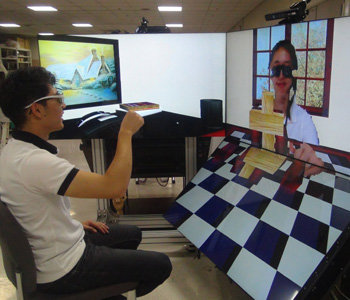Technology allows control of things in virtual reality
Technology allows control of things in virtual reality
Posted August. 05, 2015 07:22,

When a man wearing 3-D glasses raised his hand and poked it into the air, a piece of wood in the screen was pushed aside and fell off. Soon after, another man in the screen also pushed out a piece of wood. This is the so-called "virtual reality Jenga" game. The two men have accessed virtual reality from different locations and are enjoying the game.
Park Jeong-min, a researcher at the Korea Institute of Science and Technology, said on Tuesday his team had developed technology that allows users to manipulate things in virtually reality as if they are real. In a not-so-distant future, it will likely become possible for a multiple number of people to play a game simultaneously from different locations, or medical professionals to conduct simulation of surgical operation in virtual reality in advance.
The research team devised a method to manipulate things in virtual reality by using "kinect," a motion recognition sensor that is used in 3-D televisions or Microsofts game console "Xbox" First, the team inter-linked three 3-D television sets and installed two sensors on top of them. Then, they reflected visual images from the 3-D televisions by using mirrors, and put in coordinates of virtual reality on the sensors. The team made the sensors to recognize information on motions of the users who are actually moving in real space, processing the coordinates of virtual and real spaces. Simply by wearing 3-D glasses, users can experience a situation as if he is moving the thing within the 3-D video.
Microsoft also developed a similar virtual reality device, but it involved complicated apparatus, and could only operate within a space of 60 centimeters each of height, width and length. The device developed by the Korean research team can freely move things within virtual reality in a space about 2.3 times bigger than that. The new device also has a margin of about 5 millimeters, providing a high level of precision. People from different locations can simultaneously access and move the same thing in virtual reality. The device has received patent in Korea and the U.S.
jxabbey@donga.com
Headline News
- Med professors announce intention to leave hospitals starting Thursday
- Bridge honoring Sgt. Moon Jae-sik unveiled in Pennsylvania
- Chief of Staff Chung tells presidential secretaries to stay away from politics
- US FTC bans noncompete agreements
- N. Korea launches cyberattacks on S. Korea's defense companies







